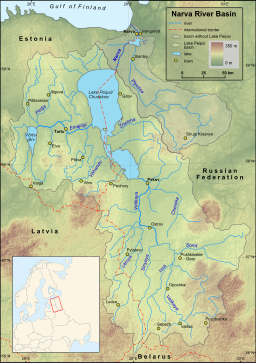Narva River
| Narva (Estonian: Narva jõgi Russian: Нарва) |
|
| River | |
|
The Narva flowing between Hermann Castle and Ivangorod Fortress
|
|
| Countries | Estonia, Russia |
|---|---|
| Tributaries | |
| - left | Jaama, Poruni, Mustajõgi |
| - right | Plyussa, Rosson |
| Cities | Narva, Ivangorod, Narva-Jõesuu |
| Source | Lake Peipsi |
| - elevation | 30 m (98 ft) |
| - coordinates | 58°59′14″N 27°43′50″E / 58.98722°N 27.73056°E |
| Mouth | Narva Bay in Finnish Gulf |
| - elevation | 0 m (0 ft) |
| - coordinates | 59°28′14″N 28°02′37″E / 59.47056°N 28.04361°ECoordinates: 59°28′14″N 28°02′37″E / 59.47056°N 28.04361°E |
| Length | 77 km (48 mi) |
| Width | 0.15–1.2 km (0–1 mi) |
| Depth | 5 m (16 ft) |
| Basin | 56,225 km2 (21,709 sq mi) |
| Discharge | |
| - average | 400 m3/s (14,126 cu ft/s) |
| Basin countries | Russia (62.9%), Estonia (30.5%), Latvia (6.6%),Belarus (minute share)(see map) |
The Narva (Estonian: Narva jõgi, Russian: Нарва) (or Narova) is a river flowing into the Baltic Sea, the largest river in Estonia by discharge. Draining Lake Peipsi, the river forms the border of Estonia and Russia and flows through the towns of Narva/Ivangorod and Narva-Jõesuu into Narva Bay. Though the river is only 77 kilometres (48 mi) long, in terms of volume discharged it is the second largest river flowing into the Gulf of Finland. The river gives its name to the Narva culture and the city of Narva.
The etymology of the toponym Narva is not clear, but according to the most common theory it comes from a Vepsian word narva meaning waterfall or stream.
The Narva river has its source at the northeastern end of Lake Peipus, near the villages of Vasknarva (Estonia) and Skyamya (Russia). There are a few more small villages on the upper section of the river, for example Permisküla and Kuningaküla on the Estonian side and Omuti on the Russian side, but up to the city of Narva the shores of the river are mostly forested or marshy land. The river is dammed entering Narva and Ivangorod, forming the Narva Reservoir, which extends up to 38 kilometres (24 mi) upstream. The Narva empties into Narva Bay near the Estonian town of Narva-Jõesuu, third largest settlement on the river after Narva and Ivangorod.
The Plyussa is the largest tributary, joining the Narva at the Narva Reservoir from the right.
...
Wikipedia


